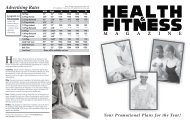How Happy Are Your Feet? - Health & Fitness Magazine online!
How Happy Are Your Feet? - Health & Fitness Magazine online!
How Happy Are Your Feet? - Health & Fitness Magazine online!
You also want an ePaper? Increase the reach of your titles
YUMPU automatically turns print PDFs into web optimized ePapers that Google loves.
HEALTH & THE ENVIRONMENT<br />
By Dr. Donna Schwontkowski<br />
(ret D.C.), M.S. Nutrition, M.H.<br />
EXERCISE/FITNESS<br />
By Maverick Jensen<br />
Chemical in the News:<br />
Bisphenol-A<br />
Note to our readers: Each month of<br />
2009 we’ll present you with an opportunity<br />
to educate yourself on chemicals<br />
in the environment and how they affect<br />
your health and the health of your<br />
children. This month’s chemical is:<br />
BISPHENOL-A.<br />
In addition, a free Special Report<br />
and the opportunity to download mp3<br />
recordings on the topic will also be<br />
available. Stay up-to-date on this very<br />
important topic and protect your health<br />
by signing up for this very useful information<br />
at www.DrDonna.info<br />
Thinking about Getting<br />
Tooth-Colored<br />
Fillings or Sealants?<br />
Better Think Again<br />
By Dr. Donna<br />
For the past year, the media has reported<br />
on the harmful chemical bisphenol-<br />
A, also known as BPA. This chemical<br />
leaches out of hard plastic baby bottles.<br />
Because the young bodies of babies are<br />
immature and unable to detoxify BPA,<br />
the health risks of BPA to children is<br />
greater than the risks to adults.<br />
BPA presents a paradigm to toxicity<br />
studies: even low levels of BPA can be<br />
problematic, with studies showing that<br />
BPA may be one of the few chemicals<br />
that is more toxic at lower doses.<br />
In over 100 studies, BPA has been<br />
linked to:<br />
• altering cell-to-cell signaling pathways<br />
on the cell surface to allow calcium<br />
efflux in cells<br />
• persistent changes to breast tissue<br />
• permanent changes to the genital tract<br />
• decreased antioxidant enzymes<br />
• increased prostate weight<br />
• increased aggression<br />
• earlier puberty<br />
• breast cells predisposed to cancer<br />
• decreased testosterone levels<br />
• insulin resistance<br />
• decreased maternal behaviors<br />
• damage to eggs and chromosomes<br />
• reversed the normal sex differences in<br />
the brain structure and behavior<br />
• hyperactivity<br />
• disruption of 200 genes<br />
• spurs the formation and growth of fat cells<br />
While much of the media focuses on<br />
BPA emanating from plastic bottles<br />
marked “7” on the triangle on the bottom<br />
of the bottle, there are three other<br />
sources of this health-ruining chemical:<br />
1.tooth-colored dental fillings. The FDA<br />
reported 50% of the fillings can be<br />
composed of bisphenol-A in 2004.<br />
2.sealants used to protect the molars of<br />
developing children.<br />
3.epoxy resin coatings on cans such<br />
as tuna, canned fruits and canned<br />
vegetables<br />
Bisphenol-A is produced in the U.S. at<br />
the rate of close to one billion pounds<br />
a year. In one Center for Disease Control<br />
study, the chemical was found in<br />
95% of the serum of 400 adults tested<br />
and identified in water, soil, the air,<br />
and in plastics.<br />
The solution to preventing BPA ingesion<br />
is simple: use glass or stainless<br />
steel containers instead of plastic, use<br />
fresh and frozen foods, avoid canned<br />
foods, and reduce sugar consumption<br />
that causes tooth decay.<br />
For more information and to find out<br />
why the FDA is downplaying the<br />
health-destroying effects of BPA, what<br />
foods are high in BPA, and other facts<br />
about the chemical, download the free<br />
Special Report: What You Should Know<br />
about Bisphenol A. <strong>How</strong> this harmful<br />
chemical affects you and your children<br />
at www.drdonna.info/bpa.html<br />
Soccer Skills<br />
<strong>How</strong> To<br />
Improve <strong>Your</strong><br />
Weaker Foot<br />
Improving your weak foot takes a serious<br />
amount of time and hard work for<br />
results to start to show. There’s no doubt<br />
that the best players in the world have almost<br />
equal ability with both feet. They can<br />
perform dummies, tricks and pass efficiently with<br />
both feet giving them more options and opportunities<br />
when they have possession of the ball. Being able to use both feet is a skill<br />
that every modern footballer needs to have.<br />
There is no real secret to improving your weaker foot other than hard work in<br />
your soccer training. As a player you need to be able to dribble with both feet<br />
giving you the sense of unpredictability against defenders. It allows you to<br />
beat defenders either using your left or right foot.<br />
To improve your weaker foot ball control you can do simple drill is such as little<br />
cuts, any kind of touches on the ball with your weaker foot is improving it.<br />
To accelerate the process of improving your weaker foot you need to perform<br />
dribbling drills such as little cuts around any kind of objects. To perform this<br />
you dribble the ball touching the ball with the inside of the foot with your<br />
weaker foot then with the outside of foot with the weaker foot and repeating<br />
this is in a continuous motion. You can then create a variations such as 2<br />
touches with the inside foot and 2 touches with the outside of the foot. Another<br />
one is two touches with the inside of the foot and one touch with the outside<br />
of the foot. There are many variations to this drill and it’s your hard work that<br />
will make these drills pay off.<br />
To improve passing with your weaker foot you simply have to use your<br />
weaker foot. This can be done by either grabbing a mate and simply passing<br />
the ball in different styles to each other, while learning and maintaining skills<br />
with your weaker foot. Or if you do not have the opportunity to grab a friend<br />
you can always find a wall and practice passing the ball and receiving the ball<br />
with the wall. It’s important when using the wall that you pick a consistent<br />
spot and try to hit it on a consistent basis. It’s crucial that you learn not only to<br />
pass the ball along the ground with your weaker foot, but to learn to chip the<br />
ball and practice your long passes. It’s crucial that you do not become a onefooted<br />
player as this will make you predictable.<br />
This article has only scratched the surface of what you can learn to learn<br />
more go to Football Smart at www.footballsmart.890m.com/ and for more<br />
on dribbling and skills go to Ball Skills at http://footballsmart.890m.com/<br />
Ball%20Skills.html<br />
38<br />
January Edition 2009









